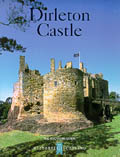 In
Dirleton
village 3m W of North Berwick on the A198. Tel: 01620 850330 In
Dirleton
village 3m W of North Berwick on the A198. Tel: 01620 850330
A romantic castle often in the forefront
of Scottish history since it was built in the 12th century. The renowned
gardens, added in the 16th century, include an Arts and Crafts
herbaceous border and Victorian garden.
The yellow clustered towers of Dirleton
Castle high on its rocky knoll strikes an imposing sight. It was
originally surrounded by a deep fresh water filled ditch which
heightened its position. Also the present victorian gardens around the
castle give a false impression since the whole area was bog and marsh
land which added to the castles outer defenses. To the east was a wooden
Barmkin which enclosed the castles town.
The first stone castle was raised by the
Anglo-Norman De Vaux family around 1225. With additions by the
Halyburtons in the 1300ís and the Ruthven family in the 1500ís.
The 1st castle consisted of four round
towers and 2 square towers set randomly around the site which was
dictated by the shape of the rocky knoll.
In 1298 the castle was attacked and
occupied by King Edward I of England. Later in 1311 King Robert the
Bruce had the castle recaptured and two of its great round towers were
slighted to ground level to make it unserviceable to the English.
In 1350 a great rebuilding work was
undertaken by the Haliburtons, a new gate house kitchen, vaults and
great hall were built on the stumps of the earlier 13th century towers.
In the 1500ís the Ruthvens added a
walled garden outside the castle and a new oblong Ruthven range to the
courtyard of the castle. Also a bee hive docot and a wall replacing the
earlier barmkin palisade was added to the castle-town.
In 1650 a group of Scottish moss troops
were operating from Dirleton attacking Cromwells convoys. Cromwell then
bombarded the castle using mortar pieces to tear open the gate house and
entered by storm.
In 1663 the castle passed to the Nisbet
family and was abandoned as a residence in favour of a new manor house
at Archerfield. The castle then became the local quarry used to build
walls and cottages locally. |
